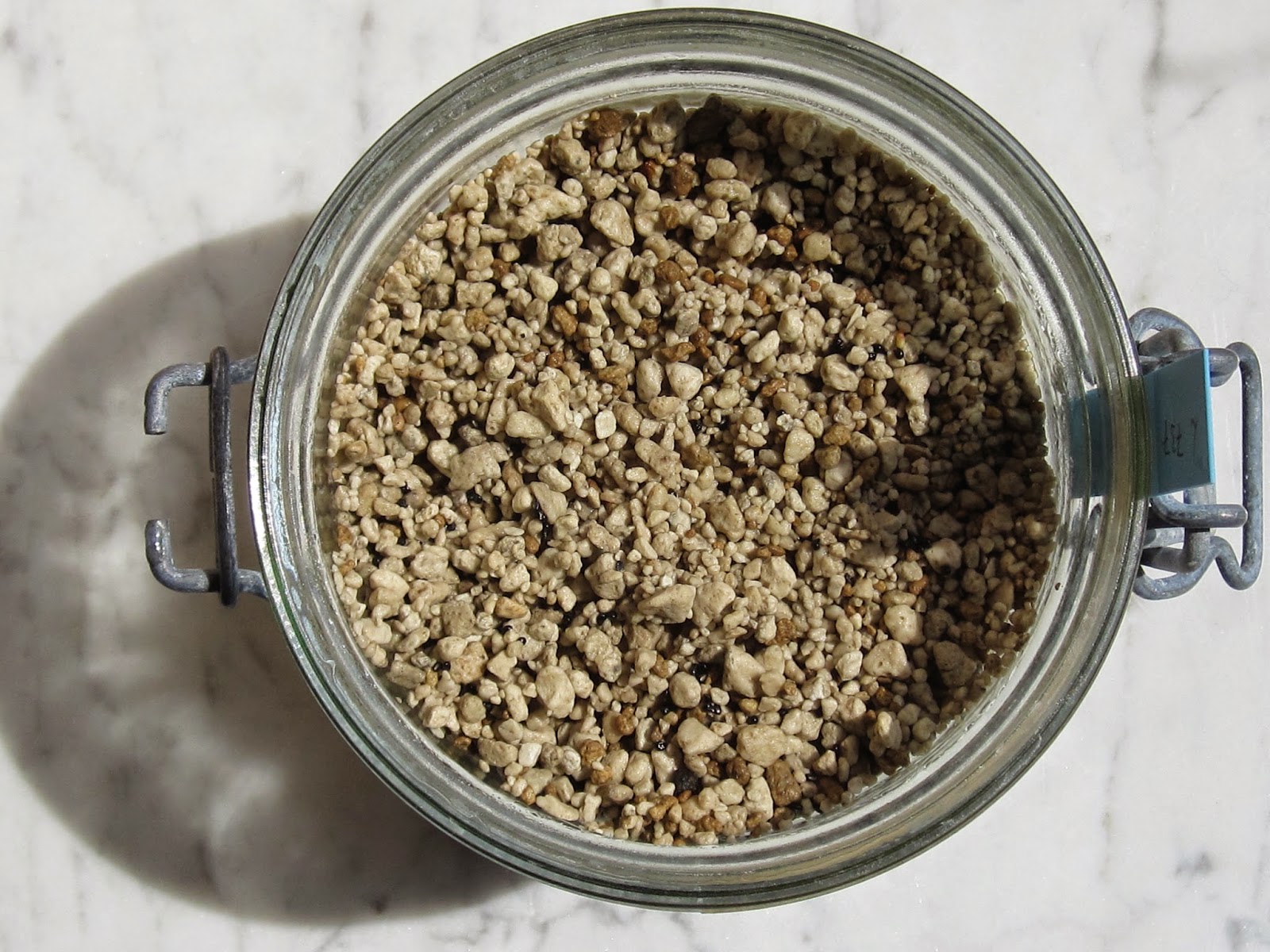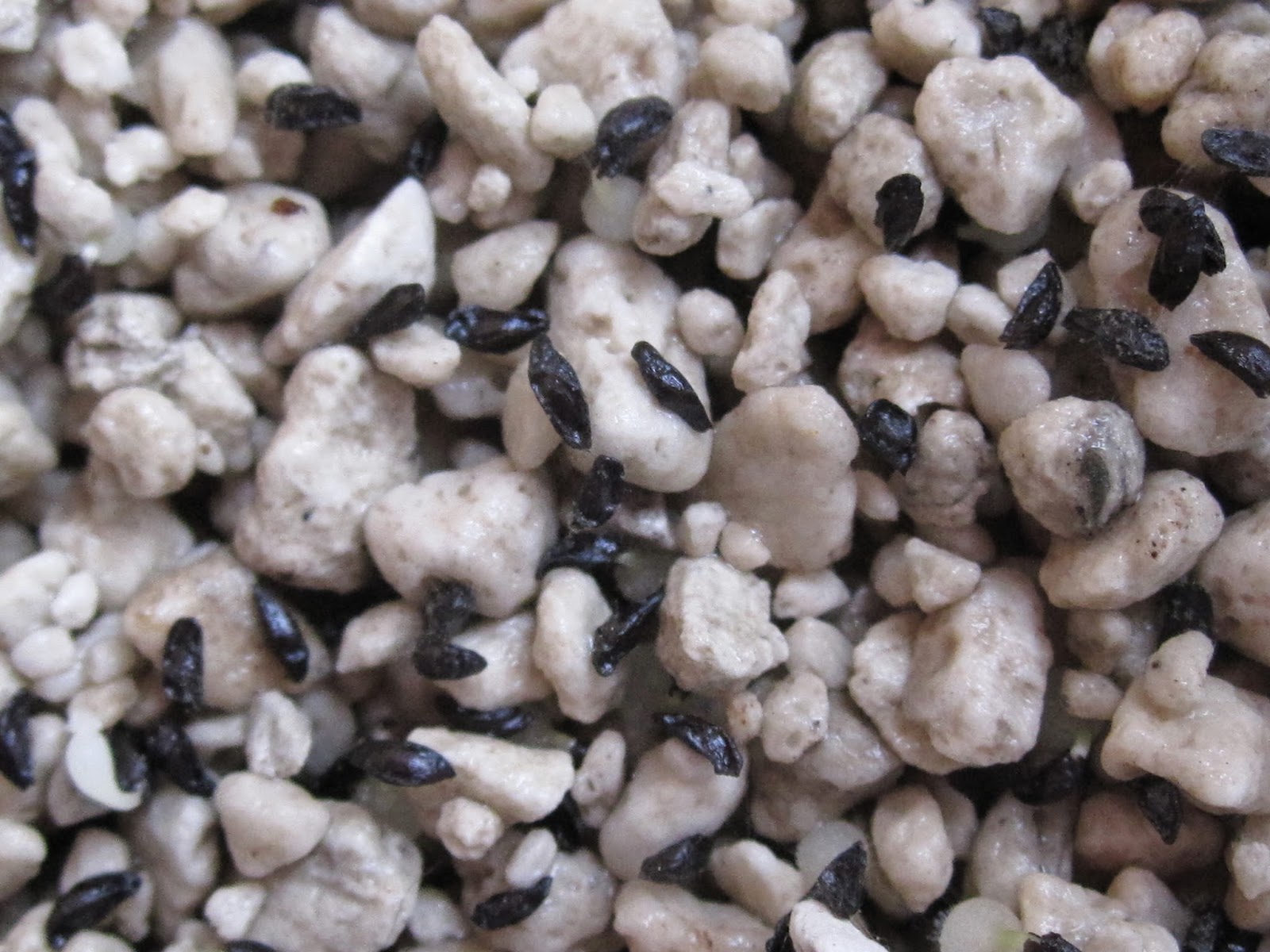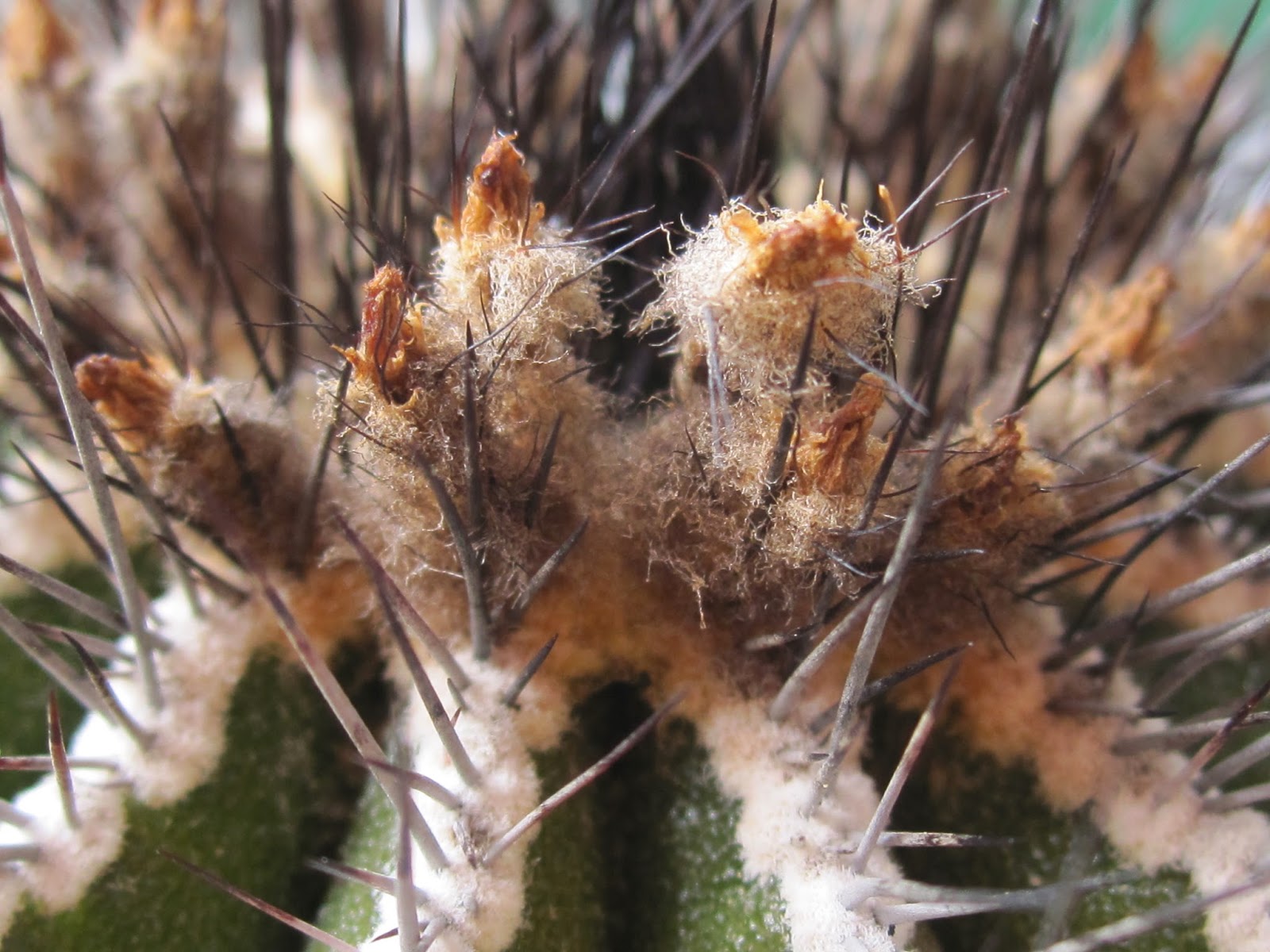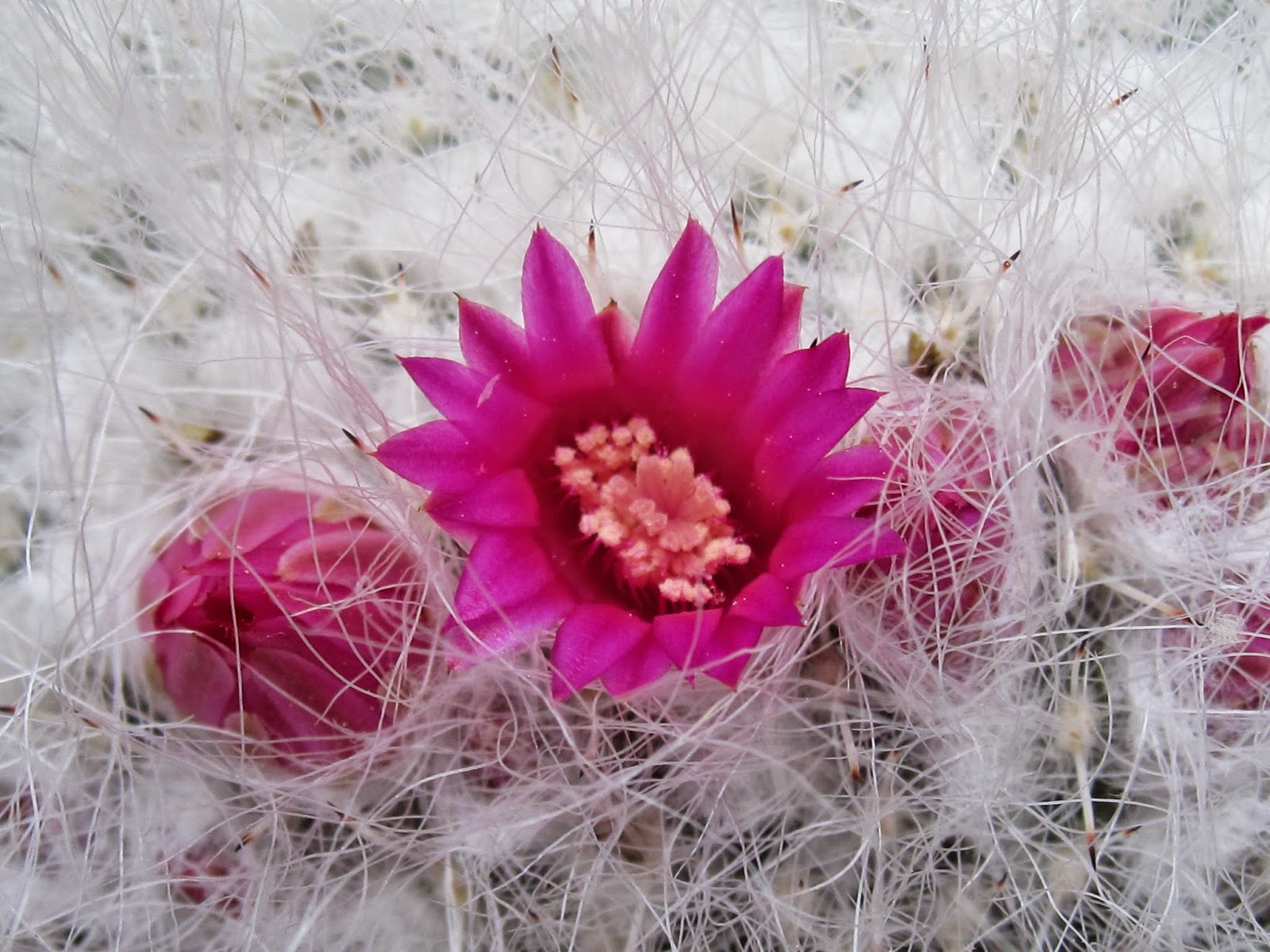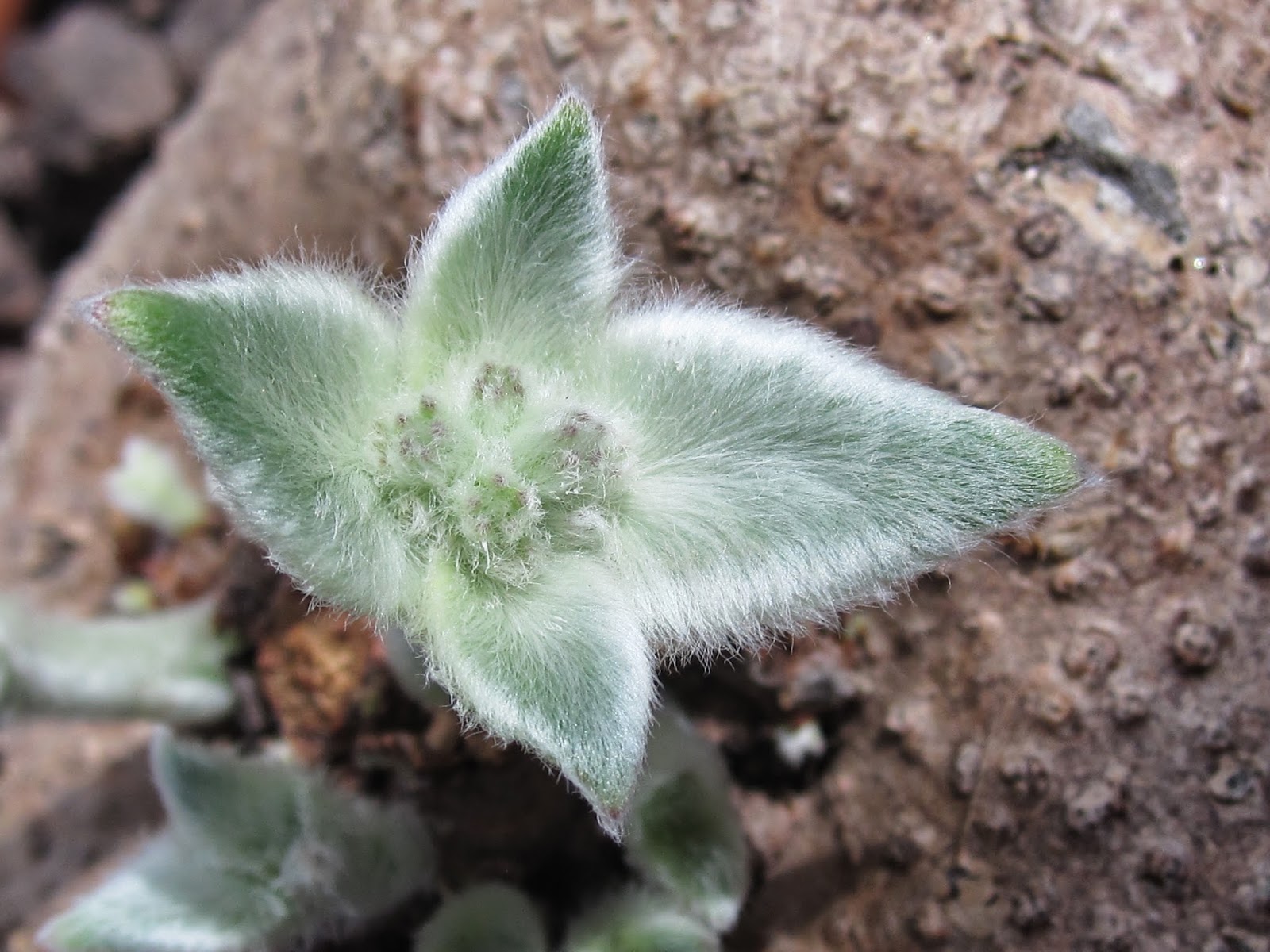15 May 2014
SOWING 2014
At the beginning of May I started for the first time to sow PSEUDOLITHOS CUBIFORMIS. The photographs have been made in mid May. I have sown 20 seeds of P. CUBIFORMIS and 20 seeds of P. MIGIURTINUS. As you can see, out of all only 2 germinated until this very day. Why? Maybe the temperature was too low or the quality of the seeds too bad. I can not tell what could be true.
substrate
This is my standard substrate for sowing. Fine grained BIMS ( = pumice ) or LAVA or PERLITE.
This time I filled it in small pods and put them in a "mini indoor greenhouse". All I have learned from growers throughout the www and forums... Sow 1 seed per pod and let it grow 1 or 2 years absolutely undisturbed! If you transplant the "little" seedling too early you might brake the roots off and therefore kill the seedling! So "I did what I have been told".
temperature
The "greenhouse" stands in my kitchen on the heater. Temperature at night will be around 15 C and at day around 25 C.
Maybe this has been a big mistake. Maybe I should have given them 25 to 30 C the whole day long. Next year I will give it another try within a commercial heating construction.
water
I have watered the pods thoroughly at the beginning of sowing. Since the first seedlings appeared I opened the "windows" at the top. So only some minor exchange of air will take place. Humidity inside the "greenhouse" is still very high.
light
The "greenhouse" stands on an eastern window and receives morning sun light only. During the day this position creates a "half shaded" position.
seeds
I have "powdered" the seeds with a fungicide. Mine is AATIRAM. It is well known, kills fungi and mould and has an inhibiting effect on the germination of the seeds too.
substrate
This is my standard substrate for sowing. Fine grained BIMS ( = pumice ) or LAVA or PERLITE.
This time I filled it in small pods and put them in a "mini indoor greenhouse". All I have learned from growers throughout the www and forums... Sow 1 seed per pod and let it grow 1 or 2 years absolutely undisturbed! If you transplant the "little" seedling too early you might brake the roots off and therefore kill the seedling! So "I did what I have been told".
temperature
The "greenhouse" stands in my kitchen on the heater. Temperature at night will be around 15 C and at day around 25 C.
Maybe this has been a big mistake. Maybe I should have given them 25 to 30 C the whole day long. Next year I will give it another try within a commercial heating construction.
water
I have watered the pods thoroughly at the beginning of sowing. Since the first seedlings appeared I opened the "windows" at the top. So only some minor exchange of air will take place. Humidity inside the "greenhouse" is still very high.
light
The "greenhouse" stands on an eastern window and receives morning sun light only. During the day this position creates a "half shaded" position.
seeds
I have "powdered" the seeds with a fungicide. Mine is AATIRAM. It is well known, kills fungi and mould and has an inhibiting effect on the germination of the seeds too.
SOWING MAY 2014
My plants have had flowered in March and April. Now in May they are setting up their fruits and seeds.
Growing season has started in March or April and is still running throughout summer and fall. So all the seeds I have harvested and will harvest around this year will be sown immediately.
The first seedlings appear very quick - if the seeds are as fresh as I use them - after one to four weeks.
I have placed the glass on the heating of my kitchen. Temperature is around 15 C at night and 25 C at day.
Light is provided by the morning sun. This makes sure that the seeds and seedlings get "soft" light in the morning and are merely standing in a "half shaded" position the rest of the day. Never forget...what is true for humans is true for animals and plants. "Young" ones allways need "shaded" or "soft" conditions while "adult" ones have learned to withstand "no shade no shelter" or "hard" conditions. This is the meaning of becoming an adult one.
As a standard I use glasses with a rubber and removable cover. These have been ex honey glasses.
My standard substrate is BIMS ( = pumice ) with a very fine grade. I might use LAVA as well or PERLITE. The great advantage is that they drain very fast surplus water, hold water and fertilizer as a sponge and let air "flow" around their grains. One disadvantage can be that algae and mosses grow very good too. So the substrate has to be sterilized and the seeds have to be powdered with fungicide. As you can see I did not cover the seeds with fungicide. The fruits are without any fruit flesh and so there should be no fungi at all on top of the seeds.
Here you might see in the center of the photograph one black seed with its "newborn" to its left. At "11 o clock" there too are two seeds which are germinating.
Growing season has started in March or April and is still running throughout summer and fall. So all the seeds I have harvested and will harvest around this year will be sown immediately.
The first seedlings appear very quick - if the seeds are as fresh as I use them - after one to four weeks.
I have placed the glass on the heating of my kitchen. Temperature is around 15 C at night and 25 C at day.
Light is provided by the morning sun. This makes sure that the seeds and seedlings get "soft" light in the morning and are merely standing in a "half shaded" position the rest of the day. Never forget...what is true for humans is true for animals and plants. "Young" ones allways need "shaded" or "soft" conditions while "adult" ones have learned to withstand "no shade no shelter" or "hard" conditions. This is the meaning of becoming an adult one.
As a standard I use glasses with a rubber and removable cover. These have been ex honey glasses.
My standard substrate is BIMS ( = pumice ) with a very fine grade. I might use LAVA as well or PERLITE. The great advantage is that they drain very fast surplus water, hold water and fertilizer as a sponge and let air "flow" around their grains. One disadvantage can be that algae and mosses grow very good too. So the substrate has to be sterilized and the seeds have to be powdered with fungicide. As you can see I did not cover the seeds with fungicide. The fruits are without any fruit flesh and so there should be no fungi at all on top of the seeds.
Here you might see in the center of the photograph one black seed with its "newborn" to its left. At "11 o clock" there too are two seeds which are germinating.
12 May 2014
STROMBOCACTUS DISCIFORMIS FLOWER 2014
In the mid of April I started to water my STROMBOCACTUS for the first time this year. At the beginning of May the first flower buds appeared.
This May we do have temperatures above 15 C at day and above 10 C at night. So I do water the plant only when we do have some sunny days with 20 C or more. Therefore the cold and rainy "April" weather of this years May may mean no harm for STROMBOCACTUS.
By the way the plant has the size of a big walnut and stands in a deep pot.
This May we do have temperatures above 15 C at day and above 10 C at night. So I do water the plant only when we do have some sunny days with 20 C or more. Therefore the cold and rainy "April" weather of this years May may mean no harm for STROMBOCACTUS.
By the way the plant has the size of a big walnut and stands in a deep pot.
ADENIA SPINOSA GROWING BEGINS...
ADENIA and ARIOCARPUS share very much the same saying. Some say they are difficult to grow, some say they present no difficulty at all. So, who is right who is wrong? All is true...
substrate
I use my standard mixture of BIMS ( = pumice ), LAVA and GRANIT or GNEIS mixed up by 1:1:1. I never add TORF ( = peat ) or other organic compounds. I do not know if lime would be preferable to add to the mix.
culture
Growing season begins around April or May. You will know it when the first shoots began to sprout. ADENIA, ADENIUM, BOWIEA, CUCURBITACEAE, CYPHOSTEMMA, DENDROSICYOS, DIDIEREACEAE und PACHYPODIUM show the same pattern when starting growing season. Very very comfortable to recognize when what has to be done.
Temperature should be above 15 C. In its habitats temperature sinks down to ... C at night and rises to 20 C at day in the coldest season. But I would be careful to "try this at home".
As in nature young plants often stand in the shade of a "mother plant" preventing the seedling from sunburn.
So I cultivate the species in half shade and some plants stand in full sun. Until today I got good results with both cultures.
Watering is done very sparse in April and or May when the growing starts. During summer and fall I water as often as possible. As a "golden rule" I water when the earth has dried out and only when temperature is over 20 C or so. Never water when weather is cold and or wet. But this "golden rule" is true for nearly every succulent.
I allways add fertilizer to the water but in a very very very low concentration.
In September or October the leaves begin to yellow and "turn to paper". Again the same is true for ADENIA, ADENIUM, BOWIEA... so you will know what to do and what should be avoided. No water, no fertilizer, as much sun as possible and cold at night should be given to harden the plants.
Any water in the substrate in connection with cold during day and night can create an infection and or mould. So this may be the time when you may loose your plant. Be careful...
As you can see I have cut away nearly all elder shoots and sprouts. The plant looked to ugly for me. Now the plant can develop new shoots and I will train them to give the plant a more beautiful look. Time will tell...
substrate
I use my standard mixture of BIMS ( = pumice ), LAVA and GRANIT or GNEIS mixed up by 1:1:1. I never add TORF ( = peat ) or other organic compounds. I do not know if lime would be preferable to add to the mix.
culture
Growing season begins around April or May. You will know it when the first shoots began to sprout. ADENIA, ADENIUM, BOWIEA, CUCURBITACEAE, CYPHOSTEMMA, DENDROSICYOS, DIDIEREACEAE und PACHYPODIUM show the same pattern when starting growing season. Very very comfortable to recognize when what has to be done.
Temperature should be above 15 C. In its habitats temperature sinks down to ... C at night and rises to 20 C at day in the coldest season. But I would be careful to "try this at home".
As in nature young plants often stand in the shade of a "mother plant" preventing the seedling from sunburn.
So I cultivate the species in half shade and some plants stand in full sun. Until today I got good results with both cultures.
Watering is done very sparse in April and or May when the growing starts. During summer and fall I water as often as possible. As a "golden rule" I water when the earth has dried out and only when temperature is over 20 C or so. Never water when weather is cold and or wet. But this "golden rule" is true for nearly every succulent.
I allways add fertilizer to the water but in a very very very low concentration.
In September or October the leaves begin to yellow and "turn to paper". Again the same is true for ADENIA, ADENIUM, BOWIEA... so you will know what to do and what should be avoided. No water, no fertilizer, as much sun as possible and cold at night should be given to harden the plants.
Any water in the substrate in connection with cold during day and night can create an infection and or mould. So this may be the time when you may loose your plant. Be careful...
As you can see I have cut away nearly all elder shoots and sprouts. The plant looked to ugly for me. Now the plant can develop new shoots and I will train them to give the plant a more beautiful look. Time will tell...
UEBELMANNIA PECTINIFERA SSP PSEUDOPECTINIFERA HU 280
This species grows in Brasil, Minas Gerais, near the town Diamantina. One population is known near the village Datas, near Diamantina. Another one will be found west of Diamantina.
The plants grow at an altitude around 1200 m on cliffs and in crevices.
Bromeliads, CIPOCEREUS MINENSIS, DISCOCACTUS PLACENTIFORMIS, PILOSOCEREUS and orchids share the same habitats.
The species grows smaller than U. PECTINIFERA. The plants reach nearly 20 cm height and width.
The spination is a little bit "wilder" as with U. PECTINIFERA. The thorns are longer and "opener" orientated as with U. PECTINIFERA, where they are filed up in a row.
My plant is grafted on an ECHINOPSIS species and is treated like all other uebelmannias.
The plants grow at an altitude around 1200 m on cliffs and in crevices.
Bromeliads, CIPOCEREUS MINENSIS, DISCOCACTUS PLACENTIFORMIS, PILOSOCEREUS and orchids share the same habitats.
The species grows smaller than U. PECTINIFERA. The plants reach nearly 20 cm height and width.
The spination is a little bit "wilder" as with U. PECTINIFERA. The thorns are longer and "opener" orientated as with U. PECTINIFERA, where they are filed up in a row.
My plant is grafted on an ECHINOPSIS species and is treated like all other uebelmannias.
UEBELMANNIA PECTINIFERA SSP FLAVISPINA HU 361
This species is growing in Brasil, Minas Gerais, in the mountains 20 km west in of the town Diamantina.
Other species of CIPOCEREUS, DISCOCACTUS and PILOSOCEREUS are growing within the same habitats.
The plants may reach a wide around 10 cm and a height up to 40 cm.
The field numbers HU 361 and HU 856 are widely spread in our collections.
As you may discover by my photographs, the species looks nearly like U. PECTINIFERA SSP PECTINIFERA.
Near the growing point of the plant, the thorns possess an amber or yellowish coulor. This turns into a brownish and grayish-blackish tone the older the thorns will become. So the name "flavispina" - meaning yellow thorn - is more a pretty exaggeration than reality.
I bought this plant on a fair this year. It had been grafted on an ECHINOPSIS. Coming home I took a closer look and...
The connection of both plants existed of only two small vessels. The rest consisted of a broad chasm. So I cut the downer part of the plant off and powdered it with charcoal powder. I hope that a new kallus is forming. Then again I will powder the basis of the plant - this time with AUXIN or GIBERELLIC ACID.
I will show you...
Other species of CIPOCEREUS, DISCOCACTUS and PILOSOCEREUS are growing within the same habitats.
The plants may reach a wide around 10 cm and a height up to 40 cm.
The field numbers HU 361 and HU 856 are widely spread in our collections.
As you may discover by my photographs, the species looks nearly like U. PECTINIFERA SSP PECTINIFERA.
Near the growing point of the plant, the thorns possess an amber or yellowish coulor. This turns into a brownish and grayish-blackish tone the older the thorns will become. So the name "flavispina" - meaning yellow thorn - is more a pretty exaggeration than reality.
I bought this plant on a fair this year. It had been grafted on an ECHINOPSIS. Coming home I took a closer look and...
The connection of both plants existed of only two small vessels. The rest consisted of a broad chasm. So I cut the downer part of the plant off and powdered it with charcoal powder. I hope that a new kallus is forming. Then again I will powder the basis of the plant - this time with AUXIN or GIBERELLIC ACID.
I will show you...
10 May 2014
FOUQUIERIA ?...? WINTER BEGINS...
These photographs have been made at the beginning of March.
Your can see only two leaves that have stayed green. All the other leaves have dried up and the whole plant has sunken into "winter" dormancy.
Its "winter" will be "our" spring and summer. It may occur that new leaves and growing appears very suddenly in the wake of the year. I will show you these sudden "explosions" of life.
The culture of this species is not the same as for all the other plants I grow. I will show you why in the coming months...
Your can see only two leaves that have stayed green. All the other leaves have dried up and the whole plant has sunken into "winter" dormancy.
Its "winter" will be "our" spring and summer. It may occur that new leaves and growing appears very suddenly in the wake of the year. I will show you these sudden "explosions" of life.
The culture of this species is not the same as for all the other plants I grow. I will show you why in the coming months...
FOUQUIERIA ?...?
I bought this plant as IDRIA COLUMNARIS but I doubt that this is what it is told to be. For me it is FOUQUIERIA FASCICULATA or MACDOUGALLII or SPLENDENS. I do have now some IDRIA COLUMNARIS at the age of 4 years. They look totally different.
"You can not trust the gardener!" or as the spoken word says "it allways is the gardener" when it comes to crime and passion.
These photographs have been taken in January 2014. As you can see it is still growing season.
"You can not trust the gardener!" or as the spoken word says "it allways is the gardener" when it comes to crime and passion.
These photographs have been taken in January 2014. As you can see it is still growing season.
THE MOST BEAUTIFUL MAMMILLARIA
For me, MAMMILLARIA HAHNIANA is the most beautiful of all the species that this genus has to offer.
Some different varieties are created and propagated. I doubt their value.
If you offer this plant as much sun as possible, if you do not water her from above and give a little bit of lime to the substrate, you too might think of her to be the most beautiful one.
Substrate...is my standard substrate. BIMS ( = pumice ), GRANIT and LAVA are mixed up by 1:1:1. Around 10% of KALK ( = lime ) and 10% of TORF (= peat ) are added to the standard mixture.
The upper cm are filled up with lime grit. This ensures that water drains very fast and that I will be remembered to myself that this is an on lime growing species.
Growing season starts in April and ends in September or October. Flowering starts - as you can see right now - with the start of the growing season in April or May.
Winter begins in October - at the beginning or the end of - and ends in March or April. No water is given in winter.
Some different varieties are created and propagated. I doubt their value.
If you offer this plant as much sun as possible, if you do not water her from above and give a little bit of lime to the substrate, you too might think of her to be the most beautiful one.
Substrate...is my standard substrate. BIMS ( = pumice ), GRANIT and LAVA are mixed up by 1:1:1. Around 10% of KALK ( = lime ) and 10% of TORF (= peat ) are added to the standard mixture.
The upper cm are filled up with lime grit. This ensures that water drains very fast and that I will be remembered to myself that this is an on lime growing species.
Growing season starts in April and ends in September or October. Flowering starts - as you can see right now - with the start of the growing season in April or May.
Winter begins in October - at the beginning or the end of - and ends in March or April. No water is given in winter.
PLEIOSPILUS NELII CV ROYAL FLUSH
PLEIOSPILUS NELII is the only species of the genus PLEIOSPILUS that does not grow at the same time as the other species of PLEIOSPILUS or LITHOPS or our cacti.
Its growing season is the same as for CONOPHYTUM.
So now in May the "winter" begins and no water shall be offered. If possible it is exposed to the sun as much as possible. If not done so the beautiful coulor will deminuish. When the worst comes to the worst it will green up. But this is a reversible reaction and it will "purple" up again when lots of sun are given.
Its growing season is the same as for CONOPHYTUM.
So now in May the "winter" begins and no water shall be offered. If possible it is exposed to the sun as much as possible. If not done so the beautiful coulor will deminuish. When the worst comes to the worst it will green up. But this is a reversible reaction and it will "purple" up again when lots of sun are given.
FLOWERING
In May of 2014 she is starting to flower.
The most beautiful character of these plants is the wooly texture of leaves and shoots. They feel like velvet. Wonderful!
The most beautiful character of these plants is the wooly texture of leaves and shoots. They feel like velvet. Wonderful!
GROWING SEASON STARTS
RECHSTEINERIA LEUCOTRICHA is nowadays called SINNINGIA LEUCOTRICHA. But you will find her much more often under her old name.
Growing season starts at the beginning of march in 2014.
I offer her as much sun as possible - the same is true for the temperature - and water her once every 2 to 4 weeks.
The substrate is a mixture of lava and peat of 1:1. The upper part of is filled up of pure lava to prevent the peat from drying out or flying away.
Growing season starts at the beginning of march in 2014.
I offer her as much sun as possible - the same is true for the temperature - and water her once every 2 to 4 weeks.
The substrate is a mixture of lava and peat of 1:1. The upper part of is filled up of pure lava to prevent the peat from drying out or flying away.
Subscribe to:
Comments (Atom)










